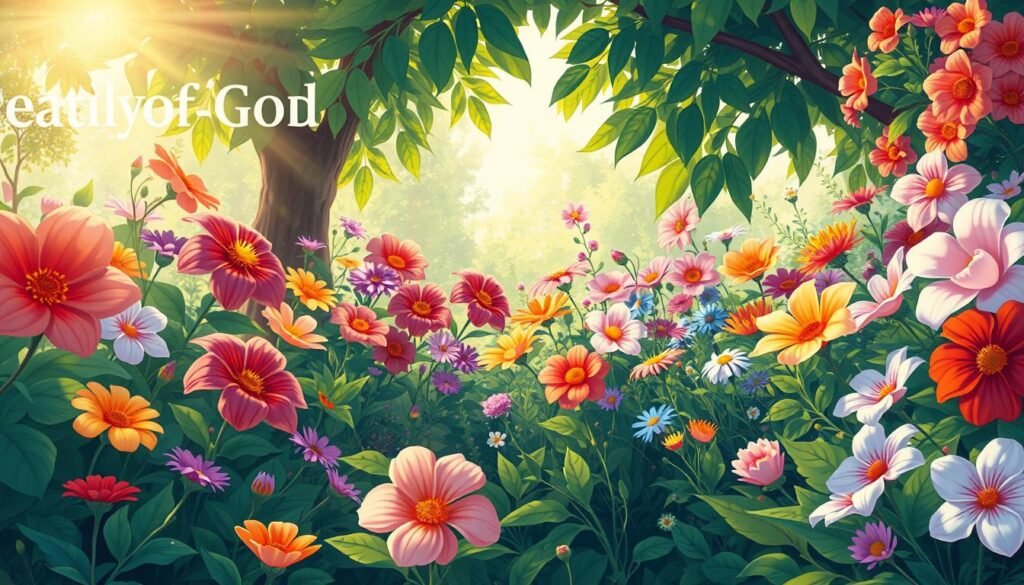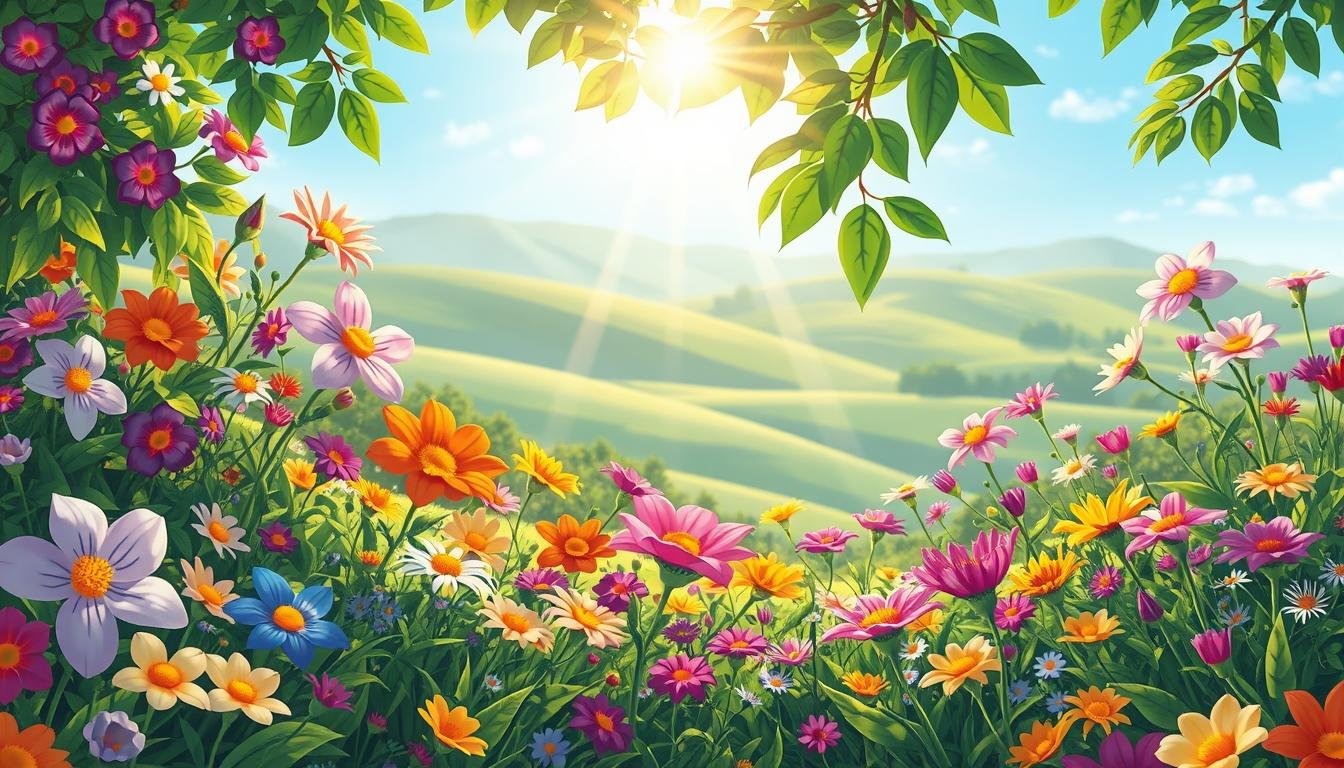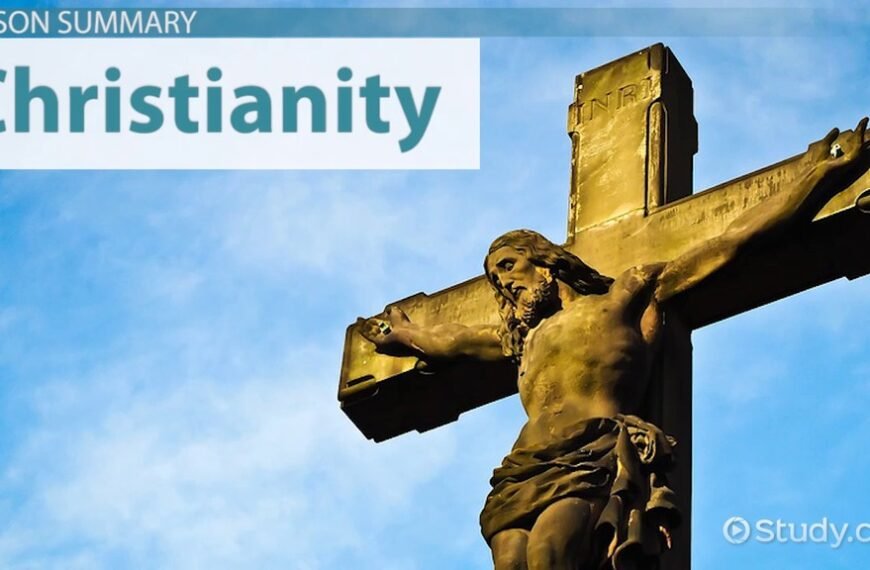Have you ever thought about how delicate flowers can show deep spiritual truths? In the Bible, flowers are more than just pretty. They show God’s amazing creation and the beauty in life.
Exploring Bible verses about flowers, we find over 30 passages. They talk about God’s care, the short time we have, and His creativity. From lilies that symbolize healing to grass that withers, these verses remind us of life’s fragility and strength.
Reading these uplifting scriptures can deepen our faith. They make us think about the beauty of nature and our spiritual paths. Let’s discover the wisdom in the Bible about flowers. It’s not just about beauty but also about our spiritual journeys.
The Symbolism of Flowers in the Bible
Flowers are mentioned about 27 times in the Bible. They symbolize beauty, life’s shortness, and God’s care. In the Song of Solomon, flowers show love and beauty. They remind us of life’s fleeting nature.
Key verses show the spiritual significance of flowers. Job 14:2 compares human life to a flower, showing its shortness. Psalm 103:16 says life is like grass, growing and then fading. These verses make us think about life’s beauty and briefness.
The lily is the most mentioned flower in the Bible, appearing at least seven times. It stands for purity and grace, showing God’s constant care. Isaiah 40:8 says, “The grass withers, the flower fades, but the word of our God will stand forever.” This verse talks about flowers’ short lives and God’s lasting promises.
Flowers are used in the Bible to teach spiritual truths. Matthew 6:28-29 talks about wildflowers, saying they are more beautiful than Solomon’s gardens. This shows God’s care and the value of His creation.
In summary, the symbolism of flowers in the Bible helps us understand God’s messages. Flowers represent growth, renewal, and God’s blessings. Appreciating the spiritual significance of flowers deepens our connection with scripture.
Exploring Bible Verses About Flowers
Biblical verses on flowers offer deep insights into nature and spirituality. Flowers in scripture are powerful symbols. For example, Matthew 6:28-30 talks about lilies to show God’s care. It teaches us to trust in God’s creation.
The Song of Solomon talks about flowers in love. In Song of Solomon 2:1-2, a rose shows the beauty of love. Song of Solomon 4:12-15 talks about a garden of flowers, showing love’s purity.
Isaiah adds to the conversation about flowers. Isaiah 35:1-2 talks about a blooming landscape as a sign of hope. It shows God’s creation can thrive even in tough times. Isaiah 40:6-8 talks about flowers fading, but God’s Word lasts forever.
The apostle Peter talks about life’s shortness in 1 Peter 1:24-25. He says God’s message is forever. James 1:10-11 also talks about life’s shortness, saying the rich will fade like flowers. Other books like Nahum, Job, and Psalms also explore the beauty and fragility of flowers.
These verses show God’s love and care. They highlight the connection between life and God. By looking at these themes, we find strength and comfort. Flowers in scripture are more than decorations; they are symbols of faith and resilience.
Song of Solomon: Love and Beauty in Bloom
The Song of Solomon flowers symbolize love and beauty in scripture. Flowers in the text represent the deep bond between lovers and between God and His people. The “rose of Sharon” and “lily of the valleys” show how love and spiritual devotion are connected.
These flowers stand for the strong emotions that grow in divine grace. They highlight the beauty and love found in scripture.
Beauty and love in scripture go beyond physical looks. The Song of Solomon shows love as a powerful and changing force. It grows, just like flowers in a garden.
Flowers remind us of life’s fleeting nature. They show the balance between earthly beauty and eternal truths. The text says that while flowers fade, love and beauty stay forever in God’s plan.
This view encourages readers to see the deeper meaning of these sacred symbols. It helps us appreciate the connection between love, beauty, and the divine.
The Transformative Power of Flowers in Isaiah 35
Isaiah 35 flowers symbolize God’s promise of renewal and restoration. This chapter shows how dry land can bloom with beauty under God’s care. It brings a deep sense of hope, showing how God can bring life and joy from nothing.
The vision of a desert turning into a fruitful oasis shows God’s power to fix broken things. It not only sees the tiredness of our spirits but also celebrates spiritual renewal. This change is at the heart of faith, reminding us that even in our toughest times, beauty can bloom through God’s help.
In the Bible, flowers often mean more than just beauty. They show God’s ongoing work in our lives, promising new beginnings. Through Isaiah 35 flowers, we see a caring God who brings renewal. He encourages us to look forward to change in our struggles.

Bible Verses About Flowers: Trusting God’s Provision
Flowers in scripture remind us of God’s care and provision. Through the Bible, we learn about trusting God through flowers. They show us God’s love for His creation and teach us to trust Him for our needs.
Matthew 6:28-30 – A Lesson in Faith
In Matthew 6:28-30, Jesus talks about lilies. He says they don’t work hard but look amazing. This teaches us a big lesson in faith. It shows that if God takes care of flowers, He will take care of us too.
The story of flowers teaches us to trust God. It tells us to have faith in His provision, even when things are tough.
Luke 12:27 – Nature’s Splendor as a Reminder
In Luke 12:27, Jesus talks about wildflowers. He says they grow without effort. This reminds us to trust God and rely on His provision.
Seeing nature’s beauty reminds us of God’s goodness. It teaches us lessons in faith through flowers. It encourages us to trust God’s faithful provision without fear.
Understanding Life’s Fragility through Flower Imagery
Flowers remind us of life’s short and delicate nature. This idea is found in many biblical texts. They show how brief and vulnerable our lives are. By looking at verses about flowers and death, we think about life’s fleeting nature and the certainty of death.
Job 14:1-2 – The Shortness of Life
In the Book of Job, a key statement says, “Man is born of woman, and is of few days and full of trouble. He comes forth like a flower and fades away.” This beautifully shows how short and troubled human life is. It compares us to flowers, showing how quickly we can fade and disappear. This encourages us to live our lives fully, knowing they are short.
Psalm 103:15-16 – The Vanishing Bloom
The Psalmist also talks about life’s shortness, saying, “As for man, his days are like grass; he flourishes like a flower of the field. For the wind passes over it, and it is gone, and its place knows it no more.” These words powerfully show life’s fragility and the theme of flowers and mortality. They make us think about our own mortality, urging us to focus on our relationship with God, despite life’s fleeting nature.
God’s Promises of Renewal: The Lily of the Valleys
The ‘lily of the valleys’ is a powerful symbol of renewal in God. It shows His promises of restoration and beauty. This flower, found in the Bible, like in Song of Solomon, represents purity and divine care. It shows God’s constant care for His creation.
In Hosea 14:5, God promises beauty will grow from His care. This is a clear sign of God’s restoration promises. Lilies symbolize the change that comes with faith, showing new beginnings and spiritual rebirth.
They remind us to trust God’s timing, just like the flowers grow in their own time. This teaches us to have faith in God, even when things are uncertain.
Every bloom is a sign of God’s faithfulness. It tells us to hold onto hope in His ability to renew us. The lily of the valleys is more than a flower. It’s a symbol of the spiritual life God offers, inviting us to experience His beauty.
Lessons from Proverbs: Beauty and Reverence
Proverbs beauty beautifully combines with reverence for God. In Proverbs 31:11, a husband’s trust in his wife shows a deep partnership. This partnership is built on mutual respect and a spiritual foundation.
The “Beautiful Truth” flower symbolizes the balance of beauty and strength. Its cream-colored, strap-like petals remind us of a biblically submissive wife. This woman is strong, relying on God, and grows spiritually and physically.

Gardening teaches us about nurturing character traits. A biblically submissive wife is like a plant that needs care. She shows self-control, discipline, and trust in God.
She focuses on the eternal, growing quietly without seeking fame. Her home and community reflect her values of frugality and contentment. These values keep her grounded, filled with gratitude for God’s gifts.
Proverbs shows how beauty is linked to reverence for God. The journey to become like the Proverbs 31 woman takes time. It encourages believers to seek God’s guidance and transformation.
Isaiah 40:6-8: The Lasting Word of God
The passage in Isaiah 40:6-8 shows the difference between nature’s fleeting beauty and God’s lasting word. It says “the grass withers and the flowers fall” to drive home a point. This reminds us that life is short, but God’s teachings and promises last forever.
It tells us, “the word of our God stands forever.” This means that even when life is unpredictable, God’s promises stay true. Flowers may bloom and then fade, but God’s word gives us hope and stability. Many translations agree, showing that God’s promises are beyond our short lives.
Thinking about flowers and our own mortality, we find comfort in God’s word. The idea that “the grass withers and the flowers fall” tells us to focus on what lasts. Scripture’s eternal nature brings us peace, especially in uncertain times. When we doubt, remembering these promises brings us peace and purpose.
The Gardener’s Role: Pruning for Growth
Scripture, especially John 15:1-2, shows God as a gardener. It explains how pruning helps us grow spiritually. This process removes things that block our spiritual growth, making us stronger.
God cares for us like a gardener, helping us grow. Pruning might hurt, but it makes our faith stronger. Proverbs 27:6 reminds us that God’s actions, even if they hurt, are full of love.
Living with disability and chronic pain for over 12 years shows the truth of trials leading to growth. Waiting for new growth after pruning is a common experience for many. At Redeemer Church of Dubai, over 60 nationalities come together each week to support each other.
When we face trials, Galatians 5:22-23 and James 1:2-4 offer comfort. They show that enduring hardship leads to spiritual fruitfulness. God prunes us for our long-term growth, reminding us that growth often comes through difficulty. Even when it seems like we’re losing something, we stay connected to Jesus, who nourishes us.
Hosea 14:5: Blossoming in God’s Care
Hosea 14:5 beautifully shows how we can bloom in God’s care. It uses images of growth to show how trusting in God makes us flourish. Just like a lily, we can show purity and beauty, reflecting God’s wish for us to grow spiritually.
This growth brings hope. It tells us that being deeply rooted in God’s love leads to renewal and thriving.
The cedar of Lebanon is a symbol of strength and stability, like the faith we need. These trees stand strong over time, just like God’s promises to us. The evergreen olive tree shows God’s grace never changes, bringing peace and blessings to us.
This verse reminds us to rely on God’s blessings every day for change. It talks about the importance of repentance for growth. By turning away from sin and seeking forgiveness, we connect deeper with God’s grace.
The sweet smells of flowers and plants remind us of the spiritual sweetness God offers. So, Hosea 14:5 is a powerful reminder of faith’s strength and the promise of blooming in God’s care.
Nature’s Celebrations: Joy in Creation
The beauty of God’s creation brings joy and inspiration to believers. Flowers and the natural world show God’s artistry. About 80% of biblical verses talk about nature, showing its importance in worship and gratitude.
As believers see God’s creation, they find joy in nature’s celebrations. This joy comes from flowers and the amazing world around us.
Scriptures like Psalms 19:1 say, “The heavens declare the glory of God; the skies proclaim the work of his hands.” This view encourages us to see nature as a display of God’s glory. It reminds us of His care for all living things.
In 24 biblical verses about nature, we see a theme of divine beauty. Flowers are mentioned often, showing God’s attention to detail. This teaches us to value God’s care in creation.
This understanding invites believers to enjoy nature’s joy. From singing mountains to jubilant fields, there’s much to celebrate. Jeremiah 10:12 talks about God’s power in making the world.
This knowledge sparks joyful worship. It encourages us to appreciate and respect God’s work. By doing so, we deepen our bond with the Creator and celebrate His wonders.
FAQ
What do flowers symbolize in the Bible?
In the Bible, flowers represent beauty, the fleeting nature of life, and God’s care. They remind us of God’s creativity and our short time on earth. This encourages us to appreciate His creation.
How can flowers uplift one’s spirit according to scripture?
Flowers uplift our spirits by showing God’s love and promises. For example, Matthew 6:28-30 tells us to trust in God’s provision. Thinking about flowers’ beauty can inspire and reassure us of God’s faithfulness.
What role do flowers play in the Song of Solomon?
In the Song of Solomon, flowers represent deep love and divine beauty. Images like the “rose of Sharon” and “lily of the valleys” show purity and love. They enrich the text, highlighting the beauty of love and spiritual connections.
What does Isaiah 35 reveal about flowers and transformation?
Isaiah 35 uses flowers to show how God can change desolation into beauty. The prophecy of the desert blooming shows God’s power to renew and restore. It talks about hope, joy, and renewal through God’s intervention.
How does scripture demonstrate trust in God’s provision through flowers?
Matthew 6:28-30 and Luke 12:27 say God provides for us just as He adorns flowers. These verses urge us to trust in God’s care and provision for our lives.
What verses reflect on life’s fragility using flower imagery?
Job 14:1-2 and Psalm 103:15-16 compare human life to flowers, showing its briefness and vulnerability. They remind us of our mortality, urging us to cherish our time and our relationship with God.
What is the significance of the lily of the valleys in scripture?
The “lily of the valleys” in Hosea 14:5 symbolizes God’s promise of renewal and vitality. It shows God’s care and ability to bring beauty and new beginnings, giving us hope and assurance of His love.
How does Proverbs teach about beauty and reverence for God?
Proverbs teaches the importance of inner spirituality over outward beauty. Flowers symbolize beauty, but true worth comes from reverencing God. It encourages us to value character and genuine spirituality over appearances.
What message does Isaiah 40:6-8 convey about God’s Word?
Isaiah 40:6-8 contrasts the fleeting nature of flowers and human glory with the permanence of God’s Word. It stresses the importance of trusting divine truths. God’s promises are steadfast, providing a solid foundation for faith.
What is the metaphorical significance of God as a gardener?
The metaphor of God as a gardener, inspired by Isaiah 18:4-5, shows His loving role in pruning. Pruning removes hindrances to spiritual growth. This invites us to see challenges as opportunities for deepening our faith in God.
How does Hosea 14:5 express themes of flourishing in God’s care?
Hosea 14:5 says God wants His people to blossom like a lily, symbolizing spiritual growth. It offers a message of hope, encouraging us to trust in God’s loving plan for our flourishing despite challenges.
How can believers celebrate joy in creation through flowers?
Flowers and nature show God’s beauty, prompting us to worship and be grateful. We are encouraged to appreciate the divine in everyday life. Celebrating the joy in creation acknowledges the splendor of God’s handiwork.

Rockin’ the faith, one verse at a time!
Growing up, the Bible’s stories deeply impacted me. Now, with over 15 years of preaching experience, I blend timeless teachings with modern technology, making them relevant for today’s world.
Bible Hub Verse is my platform to share historical insights and thought-provoking articles, exploring both familiar and uncommon Christian topics. My passion is building a welcoming online space for everyone to learn, grow in their faith, and discover the Bible’s enduring message.
Join the journey!
God bless you.







